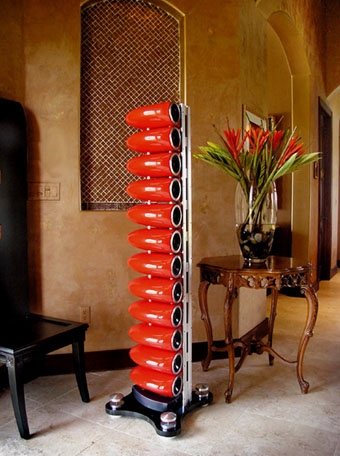Scaena Loudspeakers

Goal
To build the best Loudspeaker in the world.
Problems
The compromise of Loudspeaker design.
The Big Compromise
"A Multi Driver Quasi-Point Source Array" with varying dispersion and uneven power response.
(Acceptable, and reasonable cost)
The Impossible Best
A "Point Source Design" using a single driver, no larger then one (1) inch of piston diameter for all audio frequencies (20Hz-20Khz).
(Not yet invented)The Best Possible
A line source array using multiple drivers with even dispersion characteristics within their operating range.
(The Best, but very expensive to build)
At Scaena we build the best loudspeaker systems, limited only by the physical laws we live by. Hence, "The Iso-Linear Array".
To reproduce all frequencies up to the natural volume levels of live music, special attention was given to driver design. More then ninety percent of all musical material lies in the spectrum of 100 Hz to 5,000 Hz. This should be handled by one type of driver (with no cross - over) with a piston area no larger than 2.5 inches to keep the dispersion at almost 180 degrees.
The higher frequencies are reproduced by planar ribbon drivers that have an aperture of only one inch and match the mid-drivers flawlessly.
Our 18 inch bass-drivers are our sub-woofers. They are fast, powerful, and blend with the musical performance in both timing and energy.
Our speaker cabinets (Or lack thereof)
Generally, large speaker cabinets suffer from internally generated vibrations caused by the "back wave" generated by the loudspeaker drivers. Those vibrations can often be felt while touching the speaker cabinet during playback. Even the smallest vibration magnified by a cabinet, produces notes louder than the average acoustic output of the drivers themselves. These added notes muddy the sound and rob the music of it's "live" quality.
Each midrange driver has its own enclosure. The Iso-Linear Array enclosure is small, seamless,
leak-proof, inert, and manufactured out of a special ceramic compound. There are no parallel walls, no "standing waves", and the design is folded, creating a quasi "Helmholtz Resonator" that traps the harmful back waves transforming them into harmless heat. The individual modules (up to 18 per speaker) are isolated by
elastomer compound balls and combine mass to dampen the last possible vibrations. Cabinet resonances are all but gone.
The CNC milled aluminum "backbone" of the Scaena Loudspeaker system holds the planar/ribbon drivers in their own enclosure. They are completely isolated from the midrange drivers to perform the clearest possible high frequencies.
Bass and sub-sonics are reproduced by our 18" woofers. The cylindrical enclosure
is a machined inert enclosure internally braced and shaped for standing wave
reduction. Once again, the enclosure has no sound of its own, and clear, thundering, yet natural bass is the result. Our digital electronic cross-over and power amplifier combines the line array towers and our bass/subsonic speakers.
A loudspeaker with non-linear dispersion might test well under laboratory conditions. But position this speaker into a normal living environment with different absorbing and reflecting surfaces and the sound becomes unpredictable and possibly bad.
The Scaena " Iso-Linear Array" disperses all frequencies equally. Room reflections are linear, making set-up an easy task in any room.


